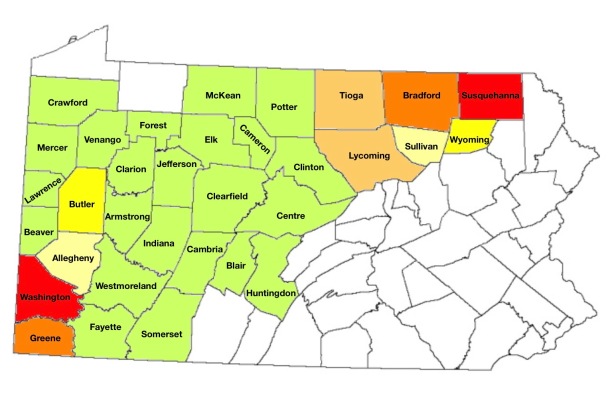Those who follow the story of the Dragonpipe (the Mariner East 2 pipeline) may be forgiven if they have the impression that large swaths of the state are being fracked, and that the fracking is concentrated in the western part of the state. The actual situation is much more nuanced.
Here’s a bit of background on Pennsylvania natural gas production, courtesy of Tom Shepstone’s Natural Gas Now (naturalgasnow.org). This is a website whose point of view I frequently disagree with, but which often reports useful information.
While about half of our counties have some level of natural gas drilling, just four counties (Susquehanna and Bradford in the northeast; Washington and Greene in the southwest) account for two-thirds of Pennsylvania production. And, if you drill down further into the data, you see that there is actually somewhat more natural gas being produced in the northeastern counties than in the western ones.
Here’s a map from Natural Gas Now showing where the drilling is concentrated.

“Wet” gas and “dry” gas. What the map doesn’t show (and the website doesn’t mention) is that the gas produced in the northeastern counties is different in composition from that produced in the western ones. The western wells produce “wet” gas, meaning that it contains lots of “natural gas liquids” (NGLs) that have to be extracted before the natural gas can be sold. Those NGLs are the products that the Dragonpipe is meant to transport.
The northeastern wells, on the other hand, produce “dry” gas. The NGL content of that gas is so low that the NGLs can simply be left in the gas. It can be sold without removing them, which greatly simplifies production processes for the gas companies.
That difference in gas content explains why the pipelines passing through our area that originate in the northeast fracking fields (and the additional ones being planned) carry only natural gas. There are no NGL pipelines from the northeastern counties, and no plans for any that I am aware of. There are plenty of environmental and safety reasons to be concerned about those pipelines, but NGLs are not involved.
For those of us who are particularly focused on the Dragonpipe, there’s a lesson here: increased natural gas production in Pennsylvania as a whole does not necessarily mean increased NGLs and increased demand for expansion of the NGL pipeline system. It is really only the production in western counties that matters for NGL volumes.
